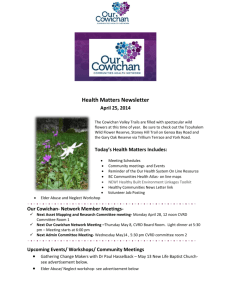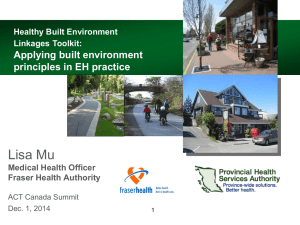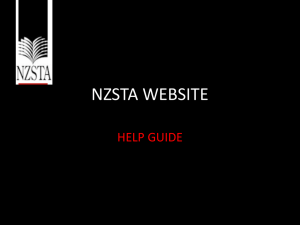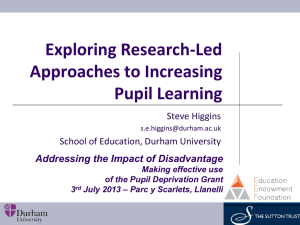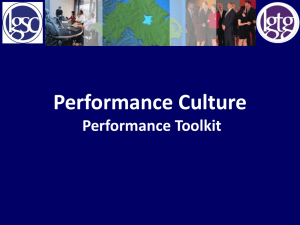(HBE) Linkages - Provincial Health Services Authority
advertisement
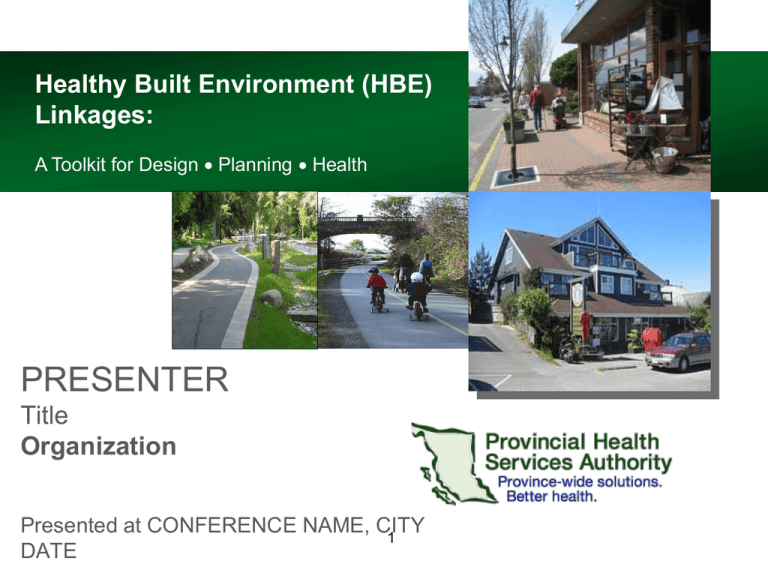
Healthy Built Environment (HBE) Linkages: A Toolkit for Design Planning Health PRESENTER Title Organization Presented at CONFERENCE NAME, CITY 1 DATE Healthy Built Environment Alliance (HBEA; the Alliance) • Knowledge sharing network • Forum for collaboration on priority activities to promote & develop built environments that encourage & support healthy living • Members from: – – – – – Land use planning Design fields Provincial ministries Health authorities Community-based health organizations – Local government – Universities/academia Healthy built environments: What do they look like? e.g., Which of these neighbourhoods is more ‘walkable’? (A) (B) Healthy built environments: How do we create them? How do you decide what to do? Examine the evidence..... …? ≠ Purpose Why did the Alliance develop another toolkit? How should we share health evidence that can support good planning and the HBE? What are our key messages about the HBE? (need for common language/consistent messaging) HBE Linkages Toolkit: Approach Collected, analyzed & summarized the evidence 1. Consultation with experts • Advisory groups – planners and content experts 2. Evidence review methodology • Literature reviews of the physical features: – – – – – Neighbourhood design Transportation Networks Natural environments Food systems Housing 3. Grading system • Systematic clustering of findings HBE Linkages Toolkit: Findings Current evidence used to identify planning principles for each of the five physical features User guide created to encourage consideration of context HBE Linkages Toolkit: What does the evidence say? HBE Linkages Toolkit: Components Planning principles for: • • • • • Healthy Neighbourhood Design Healthy Transportation Networks Healthy Natural Environments Healthy Food Systems Healthy Housing www.phsa.ca/populationhealth HBE Linkages Toolkit: Scope of Evidence Review/Toolkit • Systematic reviews • English; North America, Europe and Australia • No specified time frame • Context: urban and rural • Focused on large-scale, outdoor physical features & environments) 10 HBE Linkages Toolkit: Limitations • See User Guide! • Indirect nature of evidence linking principles to health outcomes • Toolkit identifies what should be done to create HBEs – it doesn’t get into the how • Significantly more research is available for some physical features (e.g., neighbourhood design) vs. others (e.g., food systems) 11 HBE Linkages Toolkit: Components Linkages Summary • Briefly describes the links shown in the literature between: • Planning principles • Intermediate impacts • Health-related outcomes www.phsa.ca/populationhealth HBE Linkages Toolkit: Components Fact Sheet • Describes the evidence behind each planning principle, and how these link to intermediate impacts & health-related outcomes www.phsa.ca/populationhealth HBE Linkages Toolkit: Components Health Evidence Diagram • Visually show the strength of evidence or expert opinion linking planning principles to impacts & health-related outcomes • Shows areas where more research needed www.phsa.ca/populationhealth HBE Linkages Toolkit: Summary 1) It’s a “conversation-starter” • Provides an organizing framework for presenting information and facilitating discussions between & within sectors 2) Helps users apply health evidence • Provides consistent & clear messages to inform the development of other documents & support decision-making around health & the built environment 3) Identifies where more research needed • Toolkit provides a roadmap for emerging and innovative evidence HBE Linkages Toolkit: Next Steps Sustainability plan • Monitor the evidence base & periodically update the toolkit • Develop a user guide to support evidence collection/capture Evaluation plan • Track toolkit use • Seek feedback from users for toolkit improvement & suggestions for other resources needed www.phsa.ca/populationhealth Questions? • Download the HBE Linkages Toolkit www.phsa.ca/populationhealth • Contact us! pph@phsa.ca 17 Discussion Questions 1) Will the HBE Linkages Toolkit be useful for your work? If yes, please share some examples of how it will be useful. 2) Who will you share the HBE Linkages Toolkit with? 3) How do you think HBE Linkages Toolkit could be improved? 4) What additional HBE tools or resources would help support you in your work? 18
